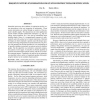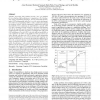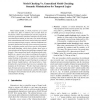422 search results - page 50 / 85 » Automatic Generation of Program Families by Model Restrictio... |
FPL
2007
Springer
14 years 18 days ago
2007
Springer
Extensible processors allow addition of application-specific custom instructions to the core instruction set architecture. These custom instructions are selected through an analys...
FAC
2008
13 years 8 months ago
2008
Abstract. Slicing is a program analysis technique that was originally introduced to improve program debugging and understanding. The purpose of a slicing algorithm is to remove the...
ASPLOS
2011
ACM
13 years 10 days ago
2011
ACM
Graphics processing units (GPUs) provide a low cost platform for accelerating high performance computations. The introduction of new programming languages, such as CUDA and OpenCL...
LICS
2005
IEEE
14 years 2 months ago
2005
IEEE
Three-valued models, in which properties of a system are either true, false or unknown, have recently been advocated as a better representation for reactive program abstractions g...
WCRE
2008
IEEE
14 years 3 months ago
2008
IEEE
CAPTCHAs are automated Turing tests used to determine if the end-user is human and not an automated program. Users are asked to read and answer Visual CAPTCHAs, which often appear...



